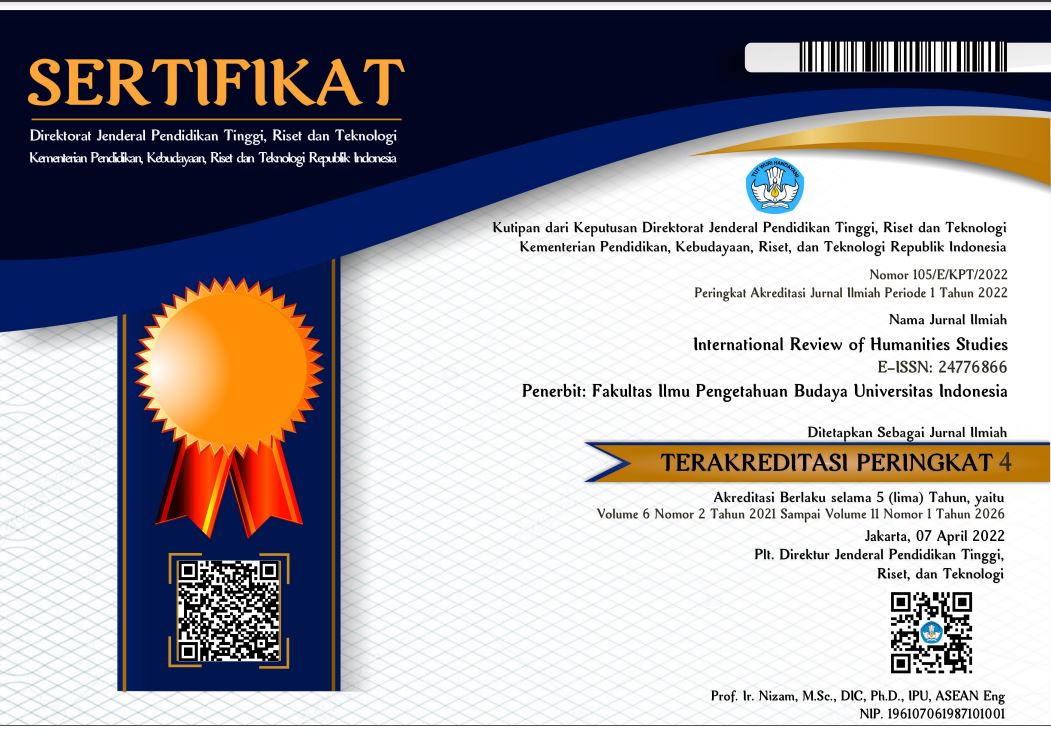International Review of Humanities Studies

Abstract
The writing of public history has become one of the methods of history that have developed and are in great demand. The difference between history in general and public history is the selection of groups that are used as research sources. Through this research, the author find that public history can be used as a way to raise historical consciousness in Indonesia. Historical Consciousness relates to thinking of ourself in time as historical beings and being aware of belonging to a specific group with a particular history and identity. The current global pandemic presents a challenge for historians. Documenting the history at the time the event was still taking place was a challenge in itself since no one knew how the end of the event was written. Public history has been widely used in European countries to record daily life and events that occurred in society during the pandemic. The historical sources collected from the public will play an important role on writing the historical event and also as a lesson in the future. The method used in this paper is a historical method consisting of 4 stages, namely heuristics, source criticism, interpretation, and then historiography.
References
_____. (2005). Hurricane Digital Memory Bank. [Online]. Available: http://hurricanearchive.org/. (Sept 10, 2020)
____. (2008). Children of the Lodz Ghetto Research Project | Home. [Online]. Available: https://www.ushmm.org/online/lodzchildren/. (Sept 23, 2020)
____. (2020) Roy Rosenzweig: Everyone a Historian. [Online]. Available: http://chnm.gmu.edu/survey/afterroy.html#2. (Sept 5, 2020)
____. (2020). Bayani Hero · A Journal of the Plague Year · Covid-19 Archive. [Online]. Available: https://covid-19archive.org/s/archive/item/22368. (Sept 21, 2020)
____. (2020). COVID-19 MKE. [Online]. Available: https://liblamp.uwm.edu/omeka/covid19mke. (Sept 25, 2020)
____. (2020). Great Grandmother's First Zoom Meeting · A Journal of the Plague Year · Covid-19 Archive. [Online]. Available: https://covid-19archive.org/s/archive/item/19581. (Sept 25, 2020)
____. Share Your Story · A Journal of the Plague Year · Covid-19 Archive. [Online]. Available: https://covid-19archive.org/. (Sept 12, 2020)
Aisiah, A., Suhartono, S., & Sumarno, S. (2016). The measurement model of historical consciousness. Research and Evaluation In Education, Vol 2, Issue 2, 2016, pp. 108-121. https://doi.org/10.21831/reid.v2i2.8399
Ayatrohaedi, & Widdyastuti, R, (2012), Pemikiran tentang pembinaan kesadaran sejarah. Jakarta: Direktorat Sejarah dan Nilai Budaya, Direktorat Jenderal Kebudayaan, Kementerian Pendidikan dan Kebudayaan.
Brahmantyo, K. (2017). Sejarah Publik di Indonesia. [Online]. Available: https://www.kompasiana.com/kbrahmantyo/5a118d9f93460825b5688b92/sejarah-publik-di-indonesia?page=all#section2. (Sept 20, 2020)
Brennan, S. (2016). “Public, First.” In Matthew K. Gold & Lauren F. Klein (Ed.), Debates In The Digital Humanities 2016. (pp. 384-390). Minnesota: University of Minnesota Press
Cauvin, T. (2018). The Rise of Public History: An International Perspective. Historia Crítica, Issue 68, 2018, pp. 3-26. https://doi.org/10.7440/histcrit68.2018.01
Cole, C. (1994). Public History: What Difference Has It Made?. The Public Historian, Vol. 16, Issue 4, pp. 9-35. https://doi.org/10.2307/3378008
Ditjen Kebudayaan. (2020). Mengembangkan Kesadaran Sejarah untuk Membangun Bangsa. [Online]. Available: http://kebudayaan.kemdikbud.go.id/mengembangkan-kesadaran-sejarah-untuk-membangun-bangsa/ (Sept 20, 2020)
Glassberg, D. (1996). Public History and the Study of Memory. The Public Historian, Vol. 18, Issue 2, pp. 7-23. https://doi.org/10.2307/3377910
Hammond, C. (1996). Reviewed Work: The Power of Place: Urban Landscapes as Public History. RACAR: revue d'art canadienne / Canadian Art Review, Vol 23, Issue 1/2, pp. 101-104. http://www.jstor.org/stable/42630556
Hanggoro, H. (2012). Mengembalikan Sejarah ke Publik. [Online]. Available: https://historia.id/politik/articles/mengembalikan-sejarah-ke-publik-PzzGP. (Sept 25, 2020)
Howe, B., & Bannan, H. (1995). Women's History, Local History, and Public History. History News,Vol 50, Issue 2, pp. 7-11. http://www.jstor.org/stable/42652350
Ismail. (1990). Peranan Sejarah dalam Pembangunan. Jakarta: Direktorat Sejarah dan Nilai Tradisional, Departemen Pendidikan dan Kebudayaan
John, L., & Russell, K. (2017). Historical Consciousness: The Remembered Past. New York: Harper & Row. https://doi.org/10.4324/9780203790045
Kuntowijoyo. (2001). Pengantar Ilmu sejarah. Yogyakarta: Yayasan Bentang Budaya.
Sayer, F. (2017). Sejarah Publik: Sebuah Panduan Praktis. Yogyakarta: Ombak.
Thorp, R. (2014). Historical Consciousness and Historical Media - A History Didactical Approach to Educational Media. Education Inquiry, Vol 5, Issue 4, pp 242-282. https://doi.org/10.3402/edui.v5.24282
UNESCO. (2020) Memory of the World. [Online]. Available: https://en.unesco.org/programme/mow. (Sept 16, 2020)
University of Technology Sydney. (2020). What is public history?. [Online]. Available: https://www.uts.edu.au/research-and-teaching/our-research/australian-centre-public-history/about-acph/what-public-history. (Sept 12, 2020)
Vickers, A. (2010). Where Are the Bodies: The Haunting of Indonesia. The Public Historian, Vol 32, Issue 1, pp. 45-58. https://doi.org/10.1525/tph.2010.32.1.45
Zündorf, I. (2017). Contemporary History and Public History. [Online]. Available: https://docupedia.de/zg/Zuendorf_public_history_v2_en_2017. (Aug 15, 2020)
Recommended Citation
Abdurakhman, Abdurakhman and Rahman, Syahidah Sumayyah
(2021)
"PUBLIC HISTORY: AN EFFORT TO INCREASE INDONESIAN HISTORICAL CONSCIOUSNESS DURING COVID-19 PANDEMI,"
International Review of Humanities Studies: Vol. 6:
No.
3, Article 11.
DOI: 10.7454/irhs.v6i3.1338
Available at:
https://scholarhub.ui.ac.id/irhs/vol6/iss3/11
Included in
Anthropology Commons, Art and Design Commons, Creative Writing Commons, Cultural Heritage Law Commons, Education Law Commons, Film and Media Studies Commons, History Commons, Intellectual Property Law Commons, International and Area Studies Commons, Legal Writing and Research Commons, Linguistics Commons, Museum Studies Commons, Philosophy Commons, Urban Studies and Planning Commons



